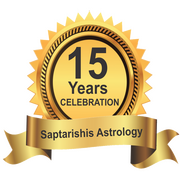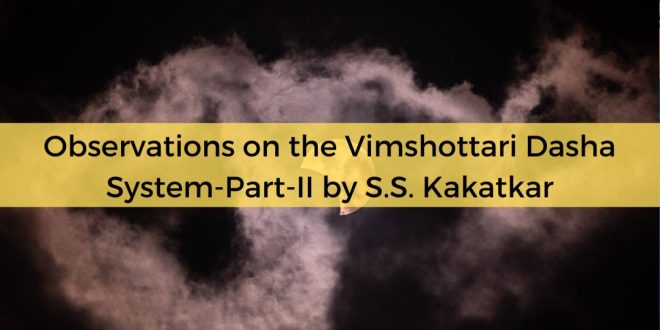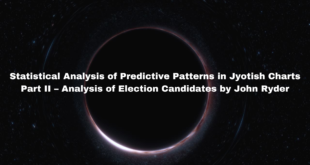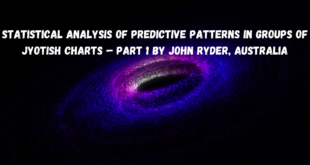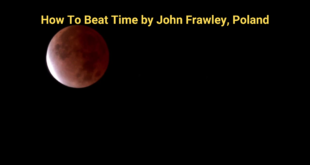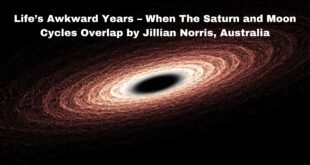Related Articles
Editor: Christine Fournier, France
Introduction
Of all the dasha systems discussed in the ancient work on astrology Brihat Parashara Hora Shastra (BPHS)1, the Vimshottari dasha system is recommended by Sage Parashara for the general populace. In this dasha system, the complete span is taken to be of 120 years as the full life span of a human being is taken to be 120 years and the nine grahas (2 luminaries, 5 planets and two lunar nodes), referred to as simply planets or grahas after this, are assigned different periods designated as mahadasha period.
In part I of this article, the correlation between dasha periods of various planets and the orbital periods of its rival planets was brought out. Rival planets were defined as planets occupying opposite houses or having natural enmity with dasha lord. Specifically, it was observed that the dasha period of a planet is equal to ten orbital or synodic periods of its rival planets or one-third the orbital period; this being the time required to traverse nine nakshatras of nine dasha lords.
A plausible logic behind this choice of 10 orbital or synodic periods or 1/3 0rbital period is explored in this part. The particular dasha sequence and placement of Rahu and Ketu within it is also discussed.
Discussion and proposed logic
An effort at offering a plausible logic for the observations in Part I is made in the following:
The observations in Part I of this article lead one to speculate that the dasha period of planets could in fact be linked to their enemy planets. It is assumed that, just as a person’s destiny is often shaped by his enemies and he can only be as successful as his enemies allow him to be, a planet can give its results only as long as its enemies allow it to. A planet and its enemies are two sides of the balance in which a person’s fate hangs. As Sage Parashara says in BPHS1, “first of all estimate the evils and checking factors thereof through Lagn and then declare the effects of the 12 Bhavas”. Similarly, the period for which a planet rules is often the period of planetary conjunctions or similar significant effects associated with the planet’s rival.
This may also be thought of as a pair of two complementary forces like Purush and Prakrti, positive and negative charge, utpatti (creation) and laya (destruction), where both need to be taken together for a complete understanding or manifestation of the Universe. Since planets form such rival pairs by virtue of being lords of houses or signs opposite each other or due to their natural enmity, a mahadasha lord can get affected in two ways- passively because of influence from planets that are its enemies or actively by expending its energy to influence other planets that consider it an enemy.
It is assumed that the foetus completes one cycle inside the womb and is launched into an appropriate higher orbit at the time of birth, depending upon the placement of moon in a given nakshatra at that time Note 1. Also, it is known that the moon takes close to 27.3 days to complete one revolution around the earth and that the synodic period of rotation of Sun (as seen from earth) is also 27.3 days. The possible effects of the rotation of Sun and its magnetosphere on personality have been studied recently2,3 from magneto-astrology point of view and put forth in a very convincing manner. The moon completes 10 full revolutions around the earth during the approximate nine month gestation period and this also corresponds to 10 synodic periods for the rotation of sun.
Sun and Moon are both enemies of Venus (or Shukra) as observed before. Thus, this theme of 10 orbital cycles of rival planet could in fact be embedded into the microcosm right from birth or indeed, if heredity and genetic factors are taken into account, then right from conception . The total dasha span of 120 years after birth may then be 10 revolutions of another rival planet of Venus, e.g. Jupiter, and within it, individual planets may again take 10 revolutions to complete the relevant dasha span of its rival graha. The word dasha itself could be a suggestive pun indicating ten.
Ten revolutions may correspond to one each from each of the nine planets and one As stated in BPHS1, the jivansh from each of the planets is reborn as human beings and the ones with high degree of paramatmansh from planets incarnate as one of the celebrated dashavataras. Ten revolutions might correspond to ten avataras of jivansh in human beings.
The synthesis of above two ideas is perhaps best manifested in the concept of Ekadash or 11 rudras4. As given in Sathapatha Brahmana, 10 of these rudras (could be various systems in the body or chakras or senses) are responsible for holding the Prana within the body that sustains the life and breathing. The eleventh Rudra is Maheswara and is responsible for the Atma (soul). The ‘going away’ of ten Rudras results in the destruction of physical body. It is therefore required that these ten rudras be eliminated or exhausted by the rival planet to bring the running dasha to an end (and conversely, be appeased by the mahadasha lord to avoid this).
A few other references to number 10 found in the literature are in order.
The number ten has also been revered as a complete number (e.g. The Pythagorean Tetraktys) as it is the sum of the first four numbers (1+2+3+4). The fascination of ancient sages, the inventors of decimal number system, with 10 is also quite understandable. The total duration of a mahayuga is 10 times the duration of Kaliyuga. It has been recognized by others that the number ten is the keynote of Solar System just as number 7 is the keynote of Earth5.The time taken to utter 10 long syllables (gurvakshara) is one prana. The periods of revolution for various planets are said to be encoded in the number of hymns in Rgveda.6. As an extension to this, we note that that there are 10 mandalas in Rgveda.
It has been pointed out in the Taittiriya and Brhadaranyaka Upanisads that there is a five-fold principle that pervades the entire universe and that the principle is manifest in the external and gross aspects as well as in the internal and subtle aspects. A pair of such complementary sets (ahoratra, exhalation-inhalation, systole-diastole) would make for a ten-fold factor. Similarly, 10 revolutions or synodic periods are required for a planet to give its results from conception of dasha period to maturity and come to fruition. When this happens, the planetary period or dasha is said to have matured and the conception of next planet’s dasha takes place. Thus, combined with the previous point, a planet gives results for 10 revolutions or 10 synodic periods of its rivals.
The vedic fire altar is enclosed by three layers of bricks for the three worlds of Earth, Atmosphere and Heaven consisting of 21, 78 and 261 for a total of 360. It can be seen that 78, the atmospheric number is 1/10th of the synodic period of Mars (780 days) and 261, the heavenly number, is 1/3 of the synodic period of Mars7, or the period required for traversing through 9 nakshatras of Vimshottari system. Mars stands for Agni, the Vedic Fire. Both these factors viz. 10 and 3 have been made use of in the present discussion to arrive at dasha periods.
From a theosophical point of view8, while seven is the “number of the manifested” on all planes of being, three is philosophically the number of the overshadowing noumenal; hence we should expect to find cycles of both seven and ten and their multiples having an appreciable influence in our progress toward the goal of fifth root-race evolution.
Several other phenomena associated with rival planets and supporting the given periods also occur simultaneously. It is possible that these effects are also responsible for the visible effects practically observed at the start or end of a dasha. The observed results could, in fact, be because of the two points 1) and 2) given above or these other miscellaneous effects or both. It cannot be determined with certainty whether all the other phenomena were known to the ancients, although some of these might have been known or deduced. However, the results and effects have always been there for everyone to study.
Dasha is given in whole years, so that the Sun returns to its original position at the start of dasha period. If the birth is exactly at the start of moon’s position in a nakshatra, then the new dasha starts and old dasha ends on birthday, otherwise, the date of start and end of first dasha period is suitably extrapolated depending upon the position of moon within the nakshatra. This evidence again supports the theory that the wheels of time keep turning independent of the observer or the birth of a newborn and it is we who have to tune our clocks in sync with the already running cosmic timemachine (kaalachakra) and the orbital motion of planets.
It is possible that at the time of conception, a snapshot of the universe (macrouniverse) gets taken as it is necessary for the microuniverse to be aligned or synchronized with the macrouniverse for its survival. The snapshot could be linked with the functioning of various systems or glands within the body or periodic magnetic effects2,3 and the external planets are mere timekeepers for these phenomena. These cycles could be set in motion or initiated at the start of Epoch for that individual i.e. time of birth, and though unique for that individual would remain attuned to the Universe as a whole. The ten revolutions could be the internal cycles of these systems before their effects stabilise. This assumption is just a possible link between the microcosm and the macrocosm.
III. Rahu, Ketu and dasha sequence
Rahu and Ketu are the lunar North and South node, respectively. A few observations are given below to explore whether they could have any other significance.
The placement of Rahu in Vimshottari system is between Mars and Jupiter. In the Solar system, the asteroid belt lies between these two planets. Also, the description of not being a point mass, appearance of coiled serpent, shesha (also means residue or what remains) fits asteroids perfectly.
Now, seen from Earth, eclipses are possible if Sun and Moon are positioned on the axis defined by lunar nodes. When seen from the Sun, such a situation is possible if a line parallel to the axis of lunar nodes is drawn through the Sun and Moon and Earth are present on it. This axis spins around the Sun with retrograde motion and orbital period of 18.6 years. It is possible that the line joining the Earth and lunar nodes or a line parallel to this line and passing through the Sun as discussed here is extended to intersect the asteroid belt, and their intersection point taken as Rahu or Ketu (See Part I).
The Sun and Moon are often taken together as a single entity and placed at the centre of the universe because of their luminosity and their central importance in our lives. This is also made evident from the fact that the Sun and Moon each own one house only so that together they own two houses like other planets. A number of biorhythms are associated with the Sun and Moon periods viz. 24 hours day and 29 days month9,10, respectively.
Another reason for this clubbing together of Sun and Moon could be that the Sun and Moon both have the same angular diameter and the same distance in terms of their own diameter viz. the distance between earth and Moon is about 108 (almost 110) times the Moon’s diameter and the Sun is about 108 Sun diameters away from the earth. This is what makes total solar eclipses possible. The diameter of Sun is 108 times the diameter of Earth. Thus, both the Sun and the Moon may be placed at the same distance. When seen from the Sun, the Earth and Moon appear at the same distance. In other words, the Sun apparently completes one revolution round the Earth in one year and the Moon takes one year to revolve around the Sun, as well.
Another reason for clubbing together of Sun and Moon could be that the moon is a timekeeper for the rotational motion of Sun due to the close similarity in their orbital and synodic period of rotation, respectively, as shown earlier. Moreover, it is known that deep down below the convective zone of Sun, everything appears to rotate with a period of 27 days and the obliquity of Sun’s plane of rotation is 7o with respect to the ecliptic, similar to that of moon. Also, important yogas like the gajakesari yoga (Jupiter and Moon conjoined in a natal chart) could in fact spring from the combined effect produced by the rotation of Sun and Jupiter on the magnetospheric pattern and barycentre movement of the Solar system2,3.
Now, if both the Sun and the moon are taken together and other planets arranged in increasing order of orbital period, we have the sequence Mercury, Venus, Sun and Moon, Mars, Rahu, Jupiter, Saturn and again Mercury etc.. Now, as Ketu is the opposite node of Rahu and for a total of nine planets sequence, distance between Ketu and Rahu dasha can only be 4 dashas in one direction and 5 dashas in the other i.e after Mercury or after Venus dasha. From Earth, Rahu is between the next two outer planets i.e. between Mars and Jupiter. Similarly on the other side, Ketu should be between the two inner planets i.e. between Mercury and Venus. Considering this symmetry, Ketu dasha logically should come after Mercury.
As per the theory of magneto-astrolgy3, it is considered likely that Mercury and Venus are the planets that first play a role early in the solar cycle by giving rise to high solar activity. They are followed by Venus and Earth, then Earth and Mars, gradually working out toward the outer planets. This would correspond to the correct dasha sequence with the Sun and Moon clubbed together and Rahu and Ketu added appropriately as given above.
The description of Hilda family objects found between the orbits of Mars and Jupiter, as that with 3 heads is similar to a multiheaded serpent or Rahu. Moreover, typical Hildas have retrograde perihelion motion. Similarly, there are Jupiter trojans with two heads in the same orbit as Jupiter. See Fig. 1, Fig.2 11.
If the orbital period of asteroids is taken as around 4.4 years as given above (orbital period of Ceres, the largest of asteroids is 4.6 years), their synodic period with Jupiter becomes 7 years, similar to the period of Jupiter’s crossing the line parallel to that of lunar nodes as given in point 1 in this section. This is also approximately the period after which there is quite a close alignment of Jupiter with the lunar nodes and the same time with Sun (also see Part I). As per the foregoing discussion, this may then correspond to the opposite node of Rahu’s i.e. Ketu’s dasha period.
Ketu itself could be the objects near Neptune. If Uranus and Neptune are taken to be the higher octaves of Mercury and Venus respectively, we get the sequence of planets starting from Sun and Moon and then continuing with the outer planets viz. Mars, Rahu (asteroids, Hilda objects, Jupiter trojans), Jupiter, Saturn, Uranus (Mercury), Ketu (cis-Neptunian objects, Neptune orbit sharer trojans), Neptune (Venus). Here, actual Mercury and Venus are ignored for dasha calculations as the mean distance from earth for Mercury, Venus and Sun is the same as that of Sun’s distance. Also, it could be theorised that the inner planets either move too swiftly or are always in company of and too close to the mighty Sun to independently give long term results (the separation between Mercury and Sun is only 28 degrees and that between Venus and Sun is 48 degrees as seen from Earth). Thus, the Sun dasha gives combined effect of Sun, Mercury and Venus, with the Sun far outweighing the other two due to its mass and brightness.
Ketu means flag and could also mean a comet as in Dhoomketu meaning comet. This has been speculated upon in some other references as well12. Considering that comets are supposed to originate in the trans-neptunian region (Kuiper belt, Oort cloud)13, this assumption of placing Ketu around Neptune appears justified. Prof. Iyengar quoting various sources notes that Ketu has been worshipped as the ninth graha and that in contemporary worship following the Rigvedic branch, the prayer for Ketu is in plural number. He also notes that Sage Parashara lists 101 comets giving their detailed descriptions, effects and time. These comets are said to be the offspring of different deities which could be a reference to the trans-Neptunian region from where they were supposed to originate. It is also interesting to note that the duration between the appearance of a number of comets is also of the order of 120 years (varying between 100-130 years), similar to one Ketu dasha period in one life span.
Finally, as per recent observations, asteroids (Rahu?) and some main belt comets (Ketu) share the same belt of asteroids13!
The vertical distance of planets above the ecliptic belt depends upon the distance of the planet and its orbital tilt14. This distance is zero for Sun as it lies on the ecliptic. For the inner planets, it increases for Venus and Mercury respectively. For the outer planets and moon, in ascending order it would increase for Moon, Mars, Jupiter and Saturn respectively. Thus, the order would be Mercury, Venus, Sun, Moon, Mars, Jupiter and Saturn. If Rahu is considered to correspond to asteroids and Ketu taken from either point 2) or 5) above, the proper dasha sequence is obtained. Also, if Uranus and Neptune are considered to be higher octaves of Mercury and Venus respectively, then, too, we recover the dasha sequence from height above ecliptic considerations.

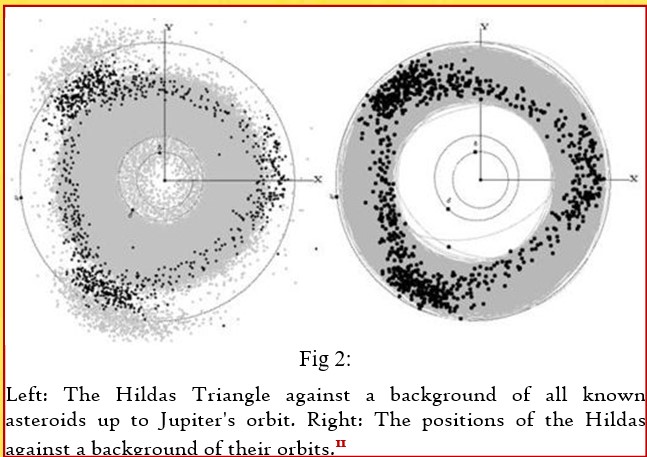
IV. Conclusion
The Vimshottari dasha system was considered and an effort was made to offer a few plausible arguments and relevant observations to explain the observed correlation between dasha periods of planets and orbital or synodic periods of their rival planets as defined in this article. The particular dasha sequence order and the placement of Rahu and Ketu within it were also considered and possible logic behind these was discussed. It was speculated that Rahu might correspond to the asteroids and Ketu to comets.
It is sincerely hoped that this article will inspire other learned workers in this field to modify and improve upon this work and extend it to other dasha systems.
Note 1: By extrapolating the same logic, the soul is said to have been launched into a still higher orbit after death. Death is merely a singularity or branch point often encountered in the theory of complex numbers in mathematics, facilitating the passage from one Riemann sheet to another. However, this is beside the point being considered here.
Learn Astrology: Join Our Upcoming Astrology Classes — Click Here
Learn Astrology: Join Our Recorded Astrology Classes — Click Here
 Saptarishis Astrology Magazine Into Creating Astrologers
Saptarishis Astrology Magazine Into Creating Astrologers
